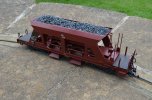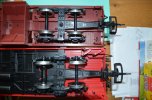HobbitFertang
Registered
Hi Folks, happy Easter one and all! I've just acquired a very nice new RhB dump wagon (LGB 46696). I was dismayed to find it derailed every time at four locations on the layout when pulled around behind a RhB loco and passenger carriage. I wondered if the bogies needed adjusting or some weight needed to be added (?). Then, after messing around with the track alignments for a couple of hours to attempt a solution (no other bogie carriages or wagons having had a problem btw), I tried adding another wagon to the back of the dumper . . . and hey presto it was absolutely fine everywhere

 . Is this 'tail-end Charley' effect recognised or is there a problem with the track or the wagon?? PS my track is fairly steep and winding
. Is this 'tail-end Charley' effect recognised or is there a problem with the track or the wagon?? PS my track is fairly steep and winding 




